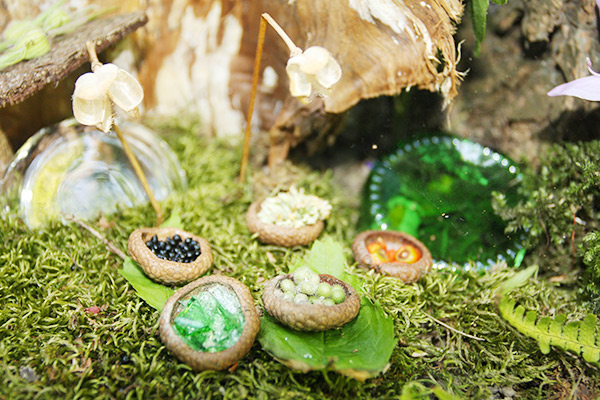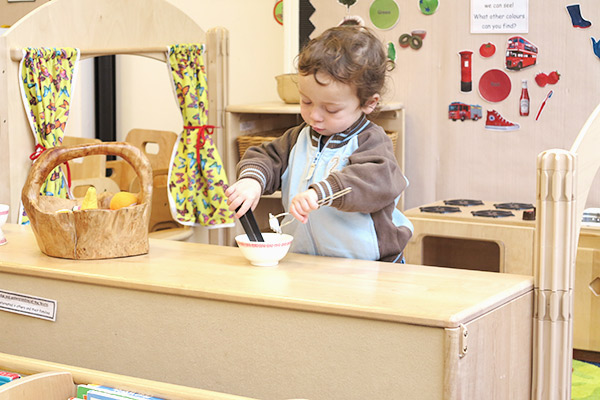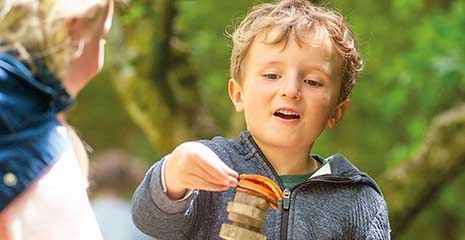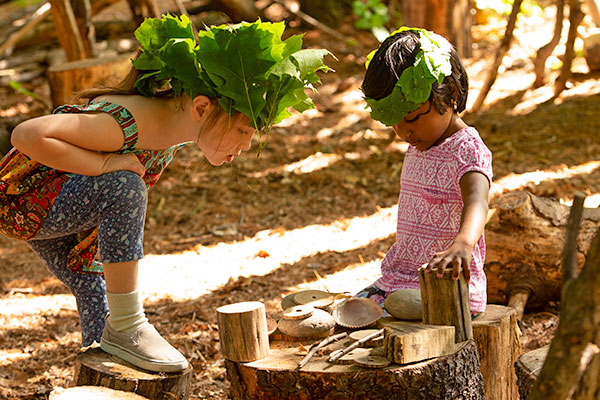Role play
Making sense of the world
| June 2018Oliver and Zara, both four, were playing daddy and mummy outdoors. They made stick “children”, and then Zara said, “Let’s make a banquet for our children!” Oliver replied, “Banquet! What’s a banquet?” Zara explained, and they laid leaves on a stump as plates. Then they dished out seeds and flowers to represent various foods. They were busy for about 45 minutes, talking all the time.
Many areas of learning were served in this one activity. The teacher witnessed shared sustained thinking. She saw how Zara and Oliver learn from one another and use their imaginations in original, creative ways. Their play showed initiative and advanced social skills in planning, co-operation and communication.
Role play is how children make sense of their world, acting out experiences, ideas or stories. Imagination, which is at the heart of children’s role play, is more important than knowledge according to Albert Einstein, “for knowledge is limited, whereas imagination embraces the entire world.” Role play takes place throughout the setting, indoors and out. It can be encouraged in a specific area where props to further the play are provided. Arches, windows and fabrics invite children into the role play area and cosy nooks allow them to withdraw for solitary and imaginary play. Natural and recycled materials extend children’s play in open ended ways.
Learning and development observations from role play
Communication and Language
Listening and attention
- Children show awareness of their listener’s needs as they make plans, discuss ideas and act out roles.
Speaking
- Children develop confidence and skill in expressing themselves as they talk together.
- While playing, children discuss their roles using past, present and future forms of speech. They connect ideas or events with what they are acting out.
- Children who are normally quiet may “talk” on the phone as part of their role play.
- Children imitate tone of voice, body language and expression in role play.
Physical development
Moving and handling
- Role play provides opportunity for children to be active.
- While setting up their play area, and throughout play, children demonstrate gross-motor control.
- Everyday “chores” included in role play support proprioceptive development in natural ways: sweeping, ironing, lifting or pushing.
- In role play, children demonstrate fine-motor control as they handle tools: scissors and pencils for shop labels, spoons and whisks while cooking, for example.
Personal, social and emotional development
Self-confidence and self-awareness
- Children discuss their ideas of what to play, how to organise it, and their roles.
- They work as a group, adjusting their behaviour accordingly.
- Social skills and confidence are developed through role play.
Managing feelings and behaviour
- Children act out both positive and negative feelings and experiences.
- They enact their own and other’s behaviour in different circumstances.
Making relationships
- Children learn to take the lead, and to follow the lead of others.
- They take account of one another’s ideas while organising their play.
- Role play fosters empathy, enabling children to see things from another’s view point.
Literacy
Reading
- Children may attempt to link sounds and letters on reading materials in the role play area (packets, books, leaflets) or may imitate reading.
Writing
- Older children imitating adults may write words: making a shopping list, taking a phone message, or pretending to be a teacher. These “words” may just be imaginary writing.
- Children make invitations, warning signs, or directions as part of their play. These may be largely comprised of decoration and patterns.
Mathematics
Numbers
- Children may be seen counting, adding and subtracting. For example, when selling items from a shop, children work out exchanges of goods for “money”. This may include doubling or halving.
- Role play includes lots of 1-to-1 correspondence. For example, children may set the table with one spoon and one bowl for each person.
- Children explore comparisons such as: “You’ve got more than me”. They begin to estimate and perform simple calculations: “We’ll need two more” or “ There are hundreds and hundreds”.
Shape, space and measure
- Role play includes size comparison: “That bed is too small for you”, “I need a bigger bowl”.
- Role play includes spatial talk: “under the table”, “next to the chair”, “behind the door”.
- Children discuss size or weight of objects, while playing “shop” for example.
- Money is a common theme – for example at the hairdresser or optician: “How much”, “I want more”, “I haven’t got enough.”
Understanding the world
People and communities
- Children act out past and present experiences – a new baby in the family or mummy’s job.
- Role play reflects children’s understanding of similarities and differences between themselves and others, among families, communities and traditions.
- Children imitate body language, facial expression, gesture, tone of voice, and accent, demonstrating knowledge of differences between people.
The world
- As children set up role-play scenarios, they demonstrate knowledge of various environments
- Children may be seen creating different kinds of homes, for example a yurt or igloo.
Technology
- Children show their understanding of how technology is used in various environments: hoover, television, or cooker in the home; bar code scanner at the checkout counter; keyboard and phone in the office; or spanner in the garage.
- Children experiment with timers and switches, making sounds and beeps.
- Children create symbolic technology, for example building a hollow-block cooker.
Expressive art and design
Exploring and using media and materials
- Children often incorporate song, music, and dance into their play, experimenting with changing words, rhythm, and movement.
- Children may decorate their role play space with all sorts of materials. They may add curtains, flowers or natural objects.
Being imaginative
- Imagination is intrinsic to role play as children represent their ideas, thoughts, and feelings through their play.
- Even a very young child might put a piece of cloth on their head to “be” someone else.
- Children may use symbolic tools: twisting a stick “screwdriver” or using a block “hammer”.
This article is adapted from a chapter from Play and the revised EYFS, © Community Playthings 2015.










